Stalin’s mighty battleships: In 1938, the final five-year plan, under the express direction of Stalin, included a fleet of 19 ships of the line. Among these were fast battleships to succeed the old dreadnoughts of the Gangut and Imperatritza Maria class. The Sovetsky Soyuz were defined from the authorization of January 21, 1938 concerning a class of four units.
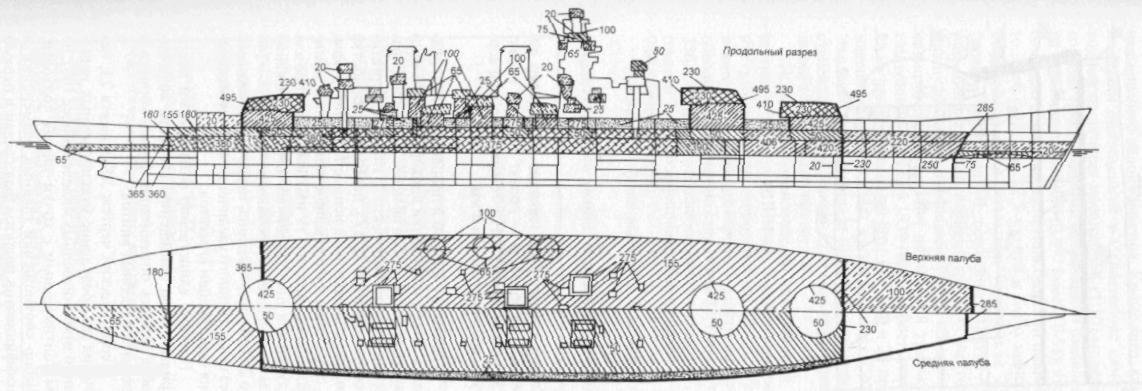
Armour scheme ad other technical specs of the Sovetsky Soyuz
From the outset, it was planned to break the limitations of Washington Treaty and of London’s. Admiral Isakov oversaw the project, retrieving data from an order dating from 1936 to the Ansaldo shipyards.
They were laid in 1938 for the first two, Sovestky Soyuz (Советский Союз) and Sovietskaya Bielorussia (Советская Белоруссия), and 1939 for the Sovietskaya Ukraina (Советская Украина). The fourth (Sovieskaya Rossiya – Советская Россия) was canceled when it quickly became apparent that the project would require considerable resources. They were known for these names as “Stalin’s Republics”.
De facto, on blueprints, these battleships reached 65,000 tons at full load, 13,000 more than the contemporary Bismarck. They were in fact closer to a Yamato, although the Soviet Union as well as the Westerners did not know the existence of the latter, and none were planned for the Pacific fleet, although initial plans were for 15 battleships, enough for all three fleets at all times. Needless to say the objective was extremely optimistic.
A single ship costed 1,180,000,000 rubles. In 1939 as was was ongoing, it was decided to keep only three ships and scrap the fourth in order to divert resources to an expanded army rearmament program. By any means, and if construction received full support, delivery would have been at best around the winter 1944-45, at which point the German naval threat was non-existent.
These impressive battleships would have been a match, if completed, for any top-of-the-line battleships in existence in any Navy. Project 23 was in tonnage on par with both the Yamato class and Montana class but with the same armament of a 20,000 tons lighter battleship, only the usual nine 406 mm in triple turrets which were the norm from 1935 designs as it maximized protection, compensated by a greater range than any competitor. However Soviet armor plate industry was unable to produce cemented armor thicker than 230 millimeters (9.1 in), making the ship only shell-proof by multiplying inner layers of smaller thicknesses in order to disperse energy.
Design of Project 23
Design work started in 1935, in response to the known Scharnhorst then in completion. A commission spent some time visiting yards in Italy and the United States, purchasing drawings until Gio. Ansaldo & C. proposed a 42,000 long tons battleship armed with nine 406 mm pieces, inspired by the Litorrio they designed. Since the Italians did not match the caliber specified, the Soviet commission also contacted an USN arsenal which already worked on such caliber for USN Battleships, although the final artillery pieces were to be forged and assembled by Obukhov and tested.
Gibbs & Cox naval architects were also contacted for two designs: One of a conventional battleship and three hybrid battleship/aircraft carriers. All thee showed a raised flight deck and central, axial reduced superstructure while the main armament was still there forwards and aft. Back home however, Soviet engineers proceeded from the conventional design and drawn their own plans.
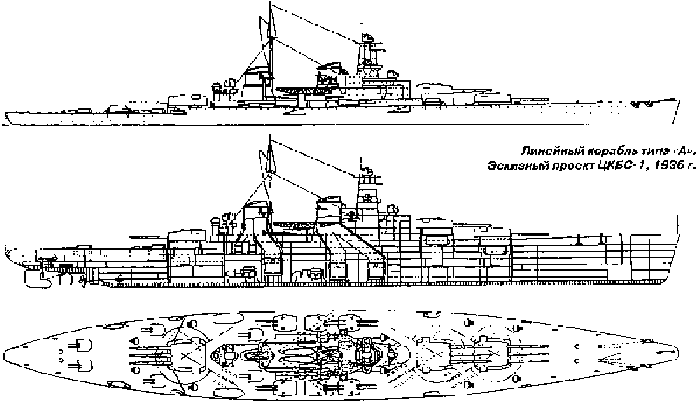
The 1936 TT3 initial design
The first Tactical-Technical Requirement (ТТЗ) was issued on 21 February 1936 but soon judged too ambitious due to the limitations of the time, combining nine 460 mm guns for 36 knots, but under a displacement of 55,000 tons. Noth only forging local guns of such caliber was a challenge, but the powerplant needed in such small displacement was unrealistic at best.
The design TT3b was revised in May 1936 by Admiral Orlov, C-in-C of the Soviet Navy, cutting the speed down to 30 knots, lowering the ain caliber to 406 mm and with less AA secondary batteries, while the displacement at 45,000 tons.
More acceptable, it was even authorized by other navies under the London treaty under the Anglo-Soviet Quantitative Naval Agreement of 1937.
Final design of the TTZ (TT3c – unofficial denomination) was approved by Orlov on 3 August.
Displacement was setup at 41,500 tons, armament to 9x 406 mm reinforced by a 12x 152 mm (6.0 in) battery and 12x 100-millimeter (3.9 in) AA plus 40x 37mm (1.5 in) AA guns. Maximum armor thickness as specified was 380 mm (15 in). Top speed as designed was 30 knots.
Soviet yards submitted their own designs and ultimately, Baltic Yards won with its KB-4 project. They later accepted on 22 November 1936 an increase of the deck armor in exchange for a displacement rising to 47,000 tons. Meanwhile, other designers lobbied Stalin for a radical increase in displacement and the latter eventually accepted in July 1936 to raise it to 56,000 tons. However this required a complete redesign, which coincided with the great purges. This unfortunate coincidence ruined all time tables and the redesign dragged on until early 1938.
The design completion was originally set to 15 October 1936, an incomplete version was presented in November. The navy’s Shipbuilding Administration specified the numerous sub-designs to be completed, such as machinery plant and secondary gun mounts and turrets.
Hull changes
In all 27 million roubles would be spent in R&D throughout 1937, testing a hull form model in a ship model basin all along 1938. More than 100 models were tested, even one-tenth-scale launches for maniability at sea, while protection was seriously tested, a replica of the future armor decks on which a 500-kilogram (1,100 lb) bomb was dropped. Tests dictated to raise the main armor deck one leverl above and a splinter deck was added underneath. Reduced models of the underwater protection, compartimentation and bulges were also tested on two barges. New modifications were made in light of this, with multiple bulkheads as the best system estimated.
Last blueprints alterations
After the final design was submitted on 28 February 1938, blueprints were edited and sent to Baltic yard where the first ship was to be laid down on 15 July. However design changes were still ongoing at that stage. At the same time was it predicted the hull form will claim almost two knots, final specs were changed again, down to 27.5 knots (50.9 km/h; 31.6 mph) designed top speed; On the same time, a new propeller design was introduced and the centerline rudder deleted.
A calculated stern-down trim also obliged to cancel the two aft quarterdeck 100 mm turrets, and the armor belt height changed two times. In fact it was raised again in 1941 by State Defense Committee. Catapults were also modified, the single axial one replaced by two, on both sides of the quarterdeck. The final hull design was established as 269.4 m long overall for 38.9 m of beam and full load a draft of 10.4 m.
However revisions of the battle displacement showed it was to reach 60,000 metric tons standard and up to 67,000 metric tons (65,942 long tons) fully loaded. It was a “full-bodies” hull, with the torpedo protection system inside it rather than external, making the ship bulkier than it really needed to be. The 7.14:1 ratio dictated powerful turbines to overcome the drag. Decision was taken by Stalin to use three shafts instead of four, saving seom weight to the armored citadel while metacentric height was 3.4 meters and radius when turning 1,170 meters (3,840 ft).
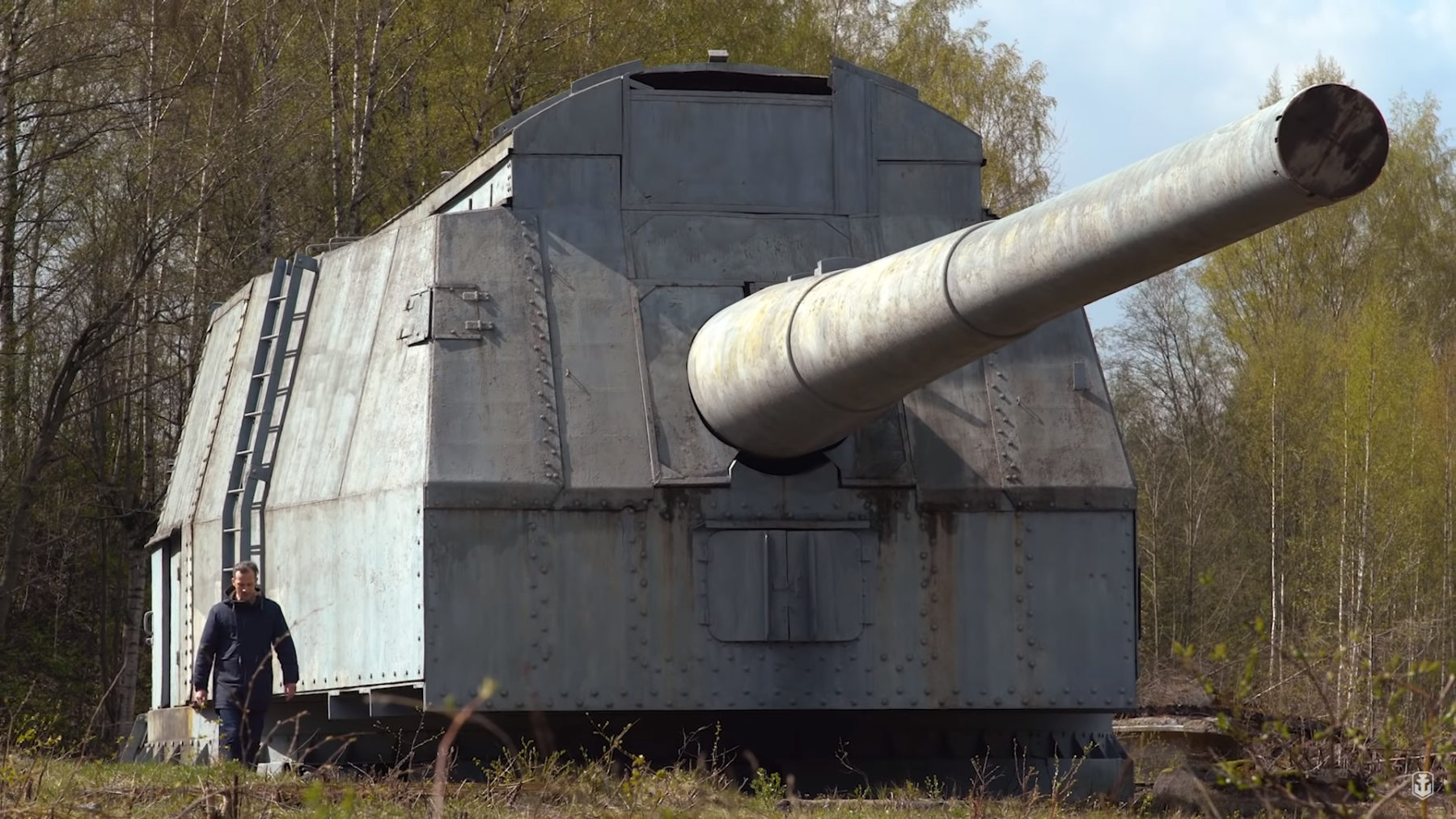
A still existing test mount for the 406 mm B-37 heavy naval guns (wow video). Such naval gun was used in the battery N°1 during the siege of Leningrad, the most impressive in the Russian arsenal up to that point, firing a total of 185 shells on German positions during the war.
Protection
Producing plates of cemented armor proved a real problem. The greater thickness achieved was 230 mm (9.1 in). Therefore it was chosen to use lower resistance cemented plates combined with face-hardened ones in November 1940. A problem soon emerged however as thinner plates were made harder, but also more brittle and ofte failed acceptance tests. They were provided anyway and in total 23,306 metric tons of the ship was made of armor protection. This was still exceptionally large, above the larger Yamato class.
Belt armor and the citadel were designed to resist 406 mm impacts as well as the decks a 500 kg bomb impact. Shells were best stopped if coming between 35° and 50° of angle from the centerline. The armor belt was thickened near the bow since the ship was narrower near the forward magazines and thicker armor installed there. This belt was 148.4m long (57% of the waterline), ad angled to 5° inwards. It was 220 mm (8.7 in) forward of the magazines.
The machinery spaces were protected by 375 mm plating with steps up to 420 mm (17 in) over the forward magazines and 380 mm (15 in) over the rear magazine. The belt ended with 30° angled transverse 285 mm bulkhead. It was downed to 250 mm on the lower deck and 75 mm (3.0 in) below. A 20 mm splinter beltwas added above up to the bow. A belt “step” 180 mm (7.1 in) was installed and a 365 mm transverse bulkhead was placed between the rear turret and the hull. The citadel was closed off by a 230 mm forward bulkhead, 180 mm rear backed by a splinter armor of 25 mm (0.98 in) above. Deck armor ranged from 25 mm (Forecastle) up to 155 mm (6.1 in) over the citadel, completed by a 50 mm middle deck and 100 mm top deck completed with a 220 mm waterline belt extension. There was also a 65 mm (2.6 in) arched deck covering the front section, and stern aft of the rear transverse bulkhead.
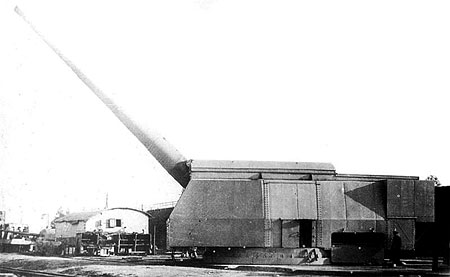
Main 406 mm in elevation tests in a provisional covered mount (not a turret), same as above, profile. These 156 tons (with breech block) pieces of ordnance were the best in the world in terms of characteristics, besides the Japanese 18-in made for the Yamato, which had a superior caliber but slightly lesser range.
The main turrets frontal arc was covered by 495 mm (19.5 in) in additive (combined) thickness as stated above, while the sides and roofs were 230 mm (9.1 in). Gun ports were 18 mm strong, and while 60 mm bulkheads separated each barrel. Barbettes were 425 mm above the upper deck and the ammo wells were thinner underneath, but protected by the citadel. MK-4 turrets were protected by 100 mm faces, down to 65 mm for their sides with 100 mm barbettes down to to 65 mm for the ammunition wells. The MZ-14 turrets were uniformely prorected by 100 mm of armour. The conning towers were 425 mm in walls thickness forward, down to 220 mm aft. The bridge tower was protected by 75 mm (3.0 in) walls.
ASW protection was tailored to withstand a 750 kg (1,653 lb) warhead TNT equivalent. The ship must survive wth five adjacent compartments flooded (Rouhly also three torpedo hits). There was a Pugliese-type protection on 123 m in the mid-section with multi-bulkhead ended system 33 m further back 8.2 m in height amidships and 7 m fore and aft. The outer layers were 14 down to 10 mm and the inner bottom 7 mm. The Pugliese cylinder had 7 mm thick walls, and the main bulkhead was 35 mm thick with a 10 mm extention below and could be filled with fuel oil or water for damping the underwater explosion energy.
Propulsion
The machinery arrangement of the sovetsky soyuz was well compartimented and separated but wing shafts were rather long at 105 meters. Wing turbine compartments were located forward of boiler room No. 1 and aft of the No. 2 turret magazines and the axial one between boiler room No. 2 and No. 3. Initially turbines were to come from Cammell Laird but the Soviet commission was rebuffed by the £700,000 price tag, and they turned to Brown Boveri for £400,000, bringing with them design features from Cammell Laird.
The latter Swiss manufacturer created single-reduction, impulse-reduction geared turbines. At first a set of four was ordered, three for the first battleship and an extra one to be sent in Kharkov to be replicated, and having Russian-built turbines provided for the next battleships. Together, once fitted, these turbines were to deliver 201,000 shaft horsepower (149,886 kW). They were fed by six triangle-type water-tube boilers per boiler room. Working pressure was 37 kg/cm2 (3,628 kPa; 526 psi) at 380 °C (716 °F).
Design speed was 27.5 knots but estimated top speed on trials shoukd have been around 28 knots, thanks to the revised propellers forced heat. Fuel oil capacity as designed was 5,280 metric tons (peacetime. Top capacity in wartime was 6,440 metric) and endurance was estimated around 6,300 nautical miles to 7,680 nautical miles (14,220 km; 8,840 mi) at 14.5 knots in maximal capacity.
Armament of the sovetsky soyuz
Main armament
Three MK-1 triple turrets with electrical power housed each three 406 mm/40 B-37 guns. Depression was −2°, elevation 45° with a fixed loading angle of 6°. Rate of fire ranged from 2.0 to 2.6 rpm, but that’s depended on the elevation. Elevate rate was 6.2°/sec., traverse 4.55° sec. 100 rounds, 1,108-kilogram (2,443 lb) were provided per gun. They exited the muzzle at 830 m/s giving a maximum range of 45,600 meters (49,900 yd) in maximal elevation, which had given these ships a very long reach: It was 39,000 m for the Iowa, even greater than the Yamato (42,000 m) and largely compensated for armour shortcomings in a naval gunfight.
Secondary armament
This secondary armament of the Sovetsky Soyuz comprised twelve B-38 152 mm/57 guns in six dual MK-4 turrets placed on each side of the main deck. Eight were aimed at all times in both frontal and chase. Elevation was −5° to +45°. Loading angle was fixed to 8°, decreasing their rate of fire to 4.8 rpm, up to 7.8 when the position was fixed.
These turrets could elevate at 13°/sec and 6°/Sec. in traverse. 170 rounds were provided, 55 kg HE shells per gun. Maximum range was 30,000 meters (98,425 ft) with a 950 m/s (3,100 ft/s) muzzle velocity. These figures were superior to the secondary battery of many battleships of the time.
Anti-aircraft defense of the Sovetsky Soyuz
Twelve 56-caliber 100 mm B-34 dual-purpose guns were installd, each with a twin MZ-14 turret, elevating to 85°, depressing to −8°. They were given 400 rounds each, 15.6-kilogram (34 lb) high explosive shells. Only by January 1941 all these turrets were installed. They can travers 12°/second, elevate at 10°/sec. Muzzle velocity was 895 m/s (2,940 ft/s), range 22,241 m against ships to to 9,895 meters (32,464 ft) ceiling.
Light AA comprised ten quadruple 37 mm 70-K gun. These water-cooled models were fitted on 46-K mounts and 1800 rounds per gun was supplied. Initial design only planned eight mounts but two more were in January 1941, on both sides of the forward superstructure. These mounts were fully enclosed, both against splinters and the muzzle blast of the larger guns. These shells were 732-kg (1.61 lb) rounds exiting the barrels at 880 m/s (2,900 ft/s) for an AA ceiling of 4,000 meters.
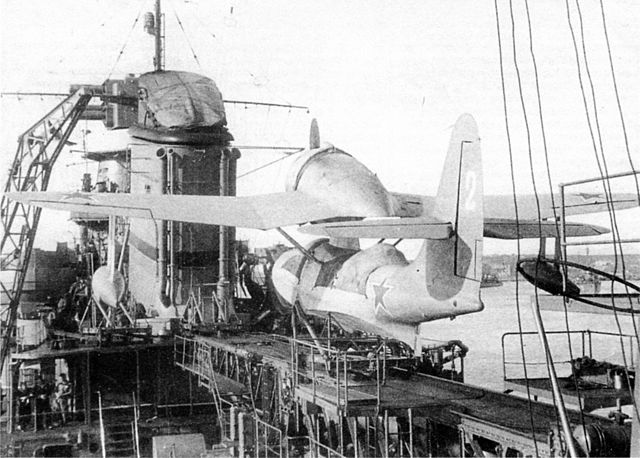
Beriev KOR-2 floatplane.
Observation and Fire control
Of course the Soviets advance in radars was nonexistent at this point. Classic telemeters were fitted. Each main turret roof was fitted with a DM-12, 12m concidence rangefinder. However main fire direction came from the three top-mounted KDP-8 fire-control directors. Their two 8-meter (26 ft 3 in) stereoscopic rangefinders tracked the target and measured the splashes distance.
Protected by 20 mm (0.79 in) armour, they were placed atop the rear superstructure, the tower-mast, and on the conning tower. The latter had 50 mm (2.0 in) of armor. In the main bridge was located the central operation TsAS-0 mechanical computer which gave firing solutions to each tower.
The secondary turrets of the Sovetsky Soyuz were served by four KDP-4t-II directors (4m rangefinders) mounted abaft the tower-mast and aft funnel. Also three SPN-300 stabilized directors were in charge of the main AA armament, either side of the forward funnel and atop the rear superstructure. For long range obersvation the ship depended on two Beriev-4 KOR-2 floatplanes. Each flew at 356 km/h (221 mph)
for a range of 1,150 km (716 miles), and outside two MGs could carry up to 400 kg (880 lb) of bombs or depth charges.
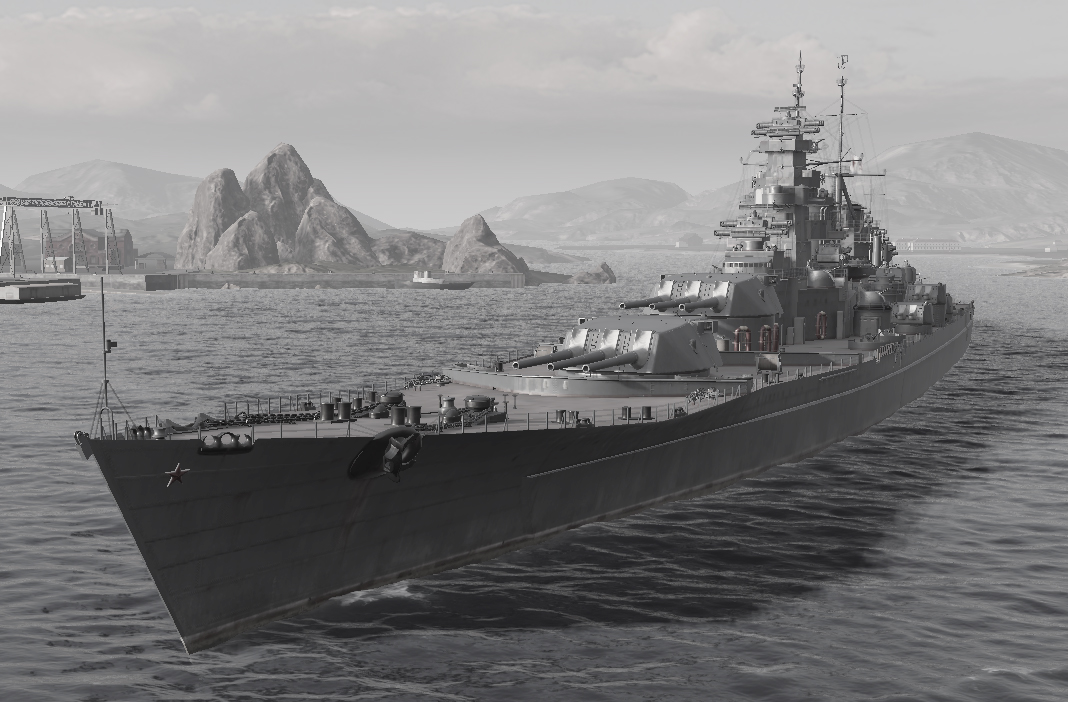
Wow’s rendition of the S. Soyuz
Fate of the Sovetsky Soyuz
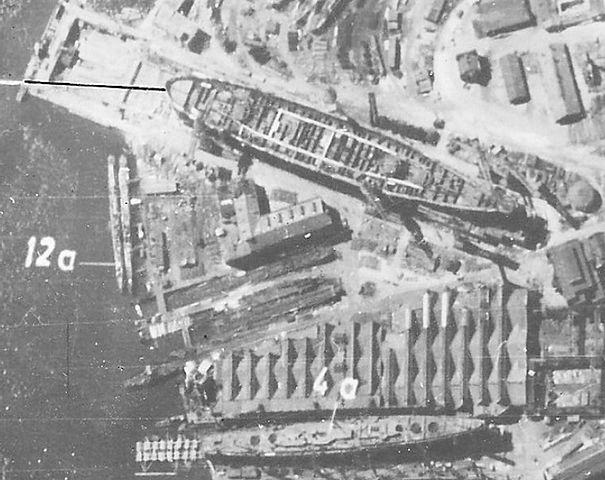
These ships were a considerable challenge as production facilities and skills were limited in USSR as shown by the Kirov series numerous issues. Production was moved to the brand-new Shipyard Nr. 402 in Molotovsk, while parts and equipments were to come from Leningrad and shipped via the White Sea Baltic Canal to Molotovsk.
Of course these plans collapsed after Operation Barbarossa. The turret shop at Nikolaev proved soon unable to fill the demands on the 406 mm guns mountings while propeller shafts were ordered in 1940 from Germany and the Netherlands. Shipbuilding steel was also plagued by quality problems which curtailed already meagre deliveries. In fact only 1,800 metric tons were delivered in 1939, a far cry of what was expected, ten times more.
Ultimately the face-hardened plates were no subsitute for proper cemented armor of large thickness. Foer propellers, the Brown Boveri turbines reach their intended yard in 1939 via Arkhangelsk, but the Kharkhovskii Turbogenerator Works which tried to copy it failed to deliver a single turbine before the German invasion. On 10 July 1941 by order of Stalin all three ships were suspended, little work went on just to keep the most advanced, Sovetsky Soyuz, to resume completion when a sedond order came on 10 September 1941, this time for a full cancellation, while all three hulls were stricken from the navy lists.

The Sovietskaya Rossiya, canceled in 1940 saw reused parts of its hull to build the Netron Menya floating battery. At the end of 1940, the hulls of the first two were 75% complete when it was decided to suspend the work. With the arrival of the Germans, the Russians withdrew trying to plasticize the hulls, but in the end, the damage was small. The Germans finished work in 1940, blowing Bielorussya’s hull.
The Soyuz and Ukraina were partially dismantled, then totally after 1946. Compared to the American Iowa, they were much wider and heavier, better protected (500 mm for the turrets) but also slower, although having still a power available quite considerable (20,000 hp more). All three were to be assigned to a fleet, that of the north (Polyarni), the fleet of the Baltic (St. Petersburg) and Odessa for the Black Sea, where they would have been formidable opponents, with an unmatched gunnery range to protect them from an enemy response.
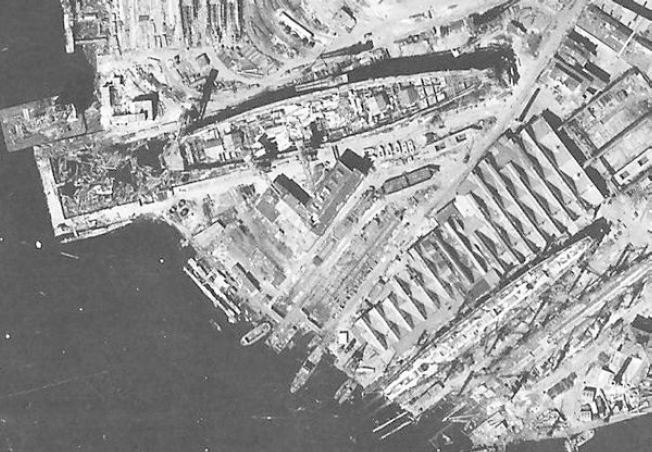

Battleship Sovetsky Soyuz probable appearance as built in 1942. Author’s illustration
3D rendition of the Project 23 class on Reddit src
See in HD VR (Virtual Reality)
Specifications 1941
Displacement: 24,000t, 27-28,000t FL
Dimensions: 181.20 x 26.80 x 9.20 m
Propulsion: 4 shaft geared turbines, 25 Yarrow boilers, 42,000 hp. 23 knots max.
Armor: 230 to 254 mm max.
Crew: 1130
Armament: -12 x 305 mm (4×3, 12 in)
-10 x 120 mm (4.7 in)
-6 x 76 mm AA (3 in)
-8 x 37 mm AA (2 in)
-8 x 12.7 mm (0.5 in) DShK MGs
-4 x 533 mm TTs (21 in) sub.
Aviation: 2x KOR-2 floatplanes
Other unfinished Soviet battleships
Apart the Tsarist Borodino, looking like a lightened, stretched-out Gangut, never completed, there were two known, REAL battleships which completion was never achieved: The modernized battlecruisers of the Konstadt class, the same plan, and in 1945, modernized battlecruiser/fast battleships of the Stalingrad class, which project evolved until 1951, when it was finalized, approved and construction launched, to be cancelled at the death of Stalin in 1953. We will develop both ships in future dedicated articles.
Stalingrad class battlecruisers (1945-51)
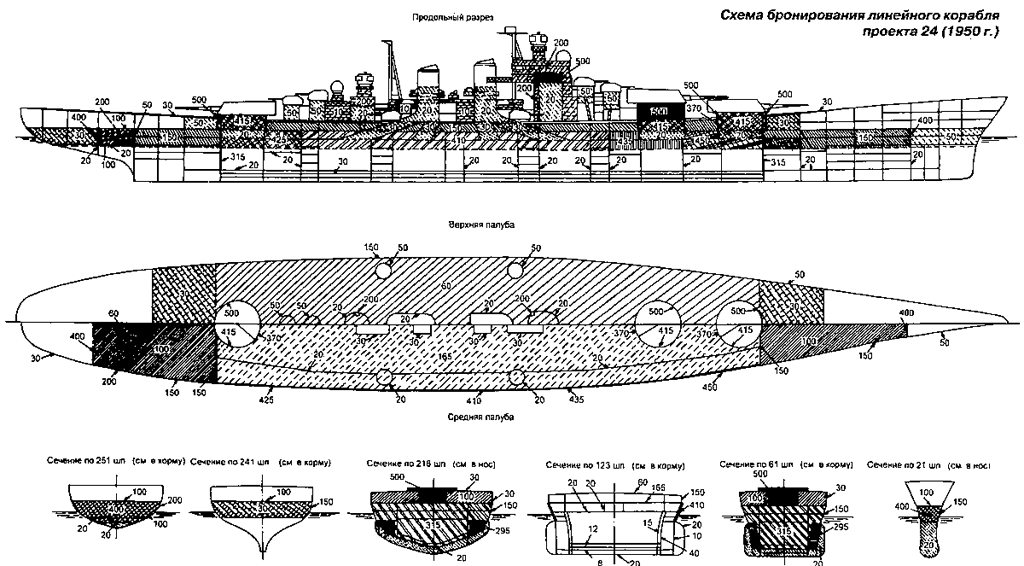
Armour protection scheme of the Stalingrad class
In 1944, various plans for reinforcing the fleet were approved, and studies were made on new battleships and cruisers. Project 24 ships, commissioned with Stalin’s insistence, were upgraded Sovietsky Soyuz, with a reinforced DCA and a tonnage of 75,000 tonnes standard, suggesting that they would be close to 85,000 tonnes as far as the 1960s USS Enterprise aircraft carrier !
Stalin, despite all the persuasive force of Admiral Kusnetsov, continued to demand a fleet of classic lines, not wanting to hear about aircraft carriers. His intransigence certainly caused the Soviet navy to lag behind during the Cold War.
Alongside Project 24, Project 82 was set up to bring a heavy cruiser of naval superiority to the fleet: It had to be armed with 254 mm pieces, then at the insistence of Stalin who wanted us to take up the idea again. Kronstadt, pieces of 305 mm. Various projects were studied between 1945 and 1957.
Finally the Kremlin leader had insisted on making corsairs in the image of the German Deustchland. The project was finalized in 1948 and changed again until 1950. Finally, the Stalingrad and Moskva were started in the 50s, the first in December 1951, the second in October 1952.
In the end, these ships planned for a start in 1955 were large but light, because of their armor designed only to withstand the shots of American cruisers, armed with 203 mm pieces. This armor was in some places thick enough to be able to participate more of the rigidity of the immense hull than the protection.
They did not have float planes, but would certainly have operated helicopters. The 130mm cannons were double and rapid fire, the 45mm cannons and the 25mm were in quadruple carriages.
The work began slowly, the group responsible for the construction of the first assuring that it would be launched for the anniversary of the revolution on November 6, 1953. In March 1953, the death of Stalin caused the immediate cessation of the construction of the first two.
Kusnetsov, returning from his “exile” from the Pacific, firmly opposed to the plans of these ships, will nevertheless try to take advantage of the study efforts made with the launch of a new hybrid missile cruiser, the Kronstadt, in May 1955, but it was canceled a few months after the keel was laid.

Stalingrad class probable appearance as built in 1955. Author’s illustration
See it in HD VR (Virtual Reality)
Specifications
Displacement: 36 500t, 42 300t FL
Dimensions: 278 x 32 x 9.20 m
Propulsion: 2 shaft turbo-electric turbines, 280,000 hp. and 35.5 knots max.
Protection: From 180 to 240 mm max;
Crew: 1700
Armament: 9 x 304, 12 x 130, 24 x 45, 40 x 25 mm AA.
Other Soviet battleships: Reality vs. Fantasy
From a game we will not mention here as it is obvious, several more designs seems to pop-out from hats, despite the fact they have little backing, at least in the West. To be convinced for example of the “Lenin” reality, once only need to google for it and see where the results are coming from. Let’s be clear: The reputed and well-documented Conway’s, confirmed by Jane’s records is not shy for exposing projects, detailing even many Western proposals, same as French, US, Japanese projects, with force details and profiles.
However, nothing is said apart the Sovietsky Soyuz class above and the battlecruisers Kronshtadt (called “large cruisers”), as well as Izmail and Stalingrad classes for two other publications. Only a list of projects could be found in the declassified archives, with very few clues to dress any sincere portayal. In what is following, some of these paper proposals even lack a proper “project” denomination.
–Project 21 (wow’s”Lenin”): Looking like a Russian version of the Rodney is its known as Project 21, a simple 1930 admiralty Study for a 35,500-ton Nelson class-style battleship.
–Project 24 (wow’s “Kreml”): It is mentioned in the continuation program, with the type 23 as “prototypes”, and decribed as a 1950 improved version of the type 23, in the 80,000 tons range.
-Project 25: It was a Study for a 30,900-ton light battleship, a cruiser-killer designed after the cancelled Project 22 and alongside the Project 68 Kronstadt class.
> “Pyotr Velikiy” – The alleged MGSh study for a fast armoured cruiser in 1907, here impersonated by the X variant of Projet 707 by Blohm und Voss in 1911, a 4×2 12-in, 21 knots armoured cruiser for the Baltic, but it can’t be backed by Conway’s. Most of the design studies were passed onto the Izmail/Borodino.
> The “Sinop” is allegedly a paper proposal designed by naval engineer Bubnov, based on a 1913-14 design for a successor to the Ganguts, in march 1914, with nine 406 mm guns in triple turrets made by Obukhov. The war cancelled all proposals. Conway’s only overviewed the Borodino design, so the unnamed Sinop has little backing, if any.
Stalin’s controversial ten-year naval plan
In 1944 Stalin drawned a ten-year naval plan (1944-1955) and insisted on building battleships to the dismay of his chief advisor, naval minister Admiral Kuznetsov. The plan included ten battleships and battlecruisers. The BS were based on the prewar Type 23. They were indeed developed by the TsKB-17 and pre-project estimates for a complete design was 1945. The Project 24 was to be a 75,000 tons battleship, 30 knots, with nine 16-in guns like the previous ship.
It was also stated a secondary battery of 24x 5.1 in in twin turrets, and uniform 24 twin 45 mm plus 60x 25 mm AA guns. The armour scheme was raised to withstand a 1000 kg bomb hit, 16-in impact. It was also roomy enough for two catapults and six planes. A photograph was released which was lated debunked as one of the Stalingrad model. It is “impersonated” by the “Kreml” while the “Validovostok” is the initial 1936 Type A battleship developed before project 23, with no less than nine 457 mm/48 and a displacement above 75,000 tons standard.
The project 25 was in essence Battleship ‘B’ study, redesignated as Project 25. It was small battleship design for the Baltic and Black Seas. It was to hunt for treaty cruisers and German pocket battleships. Its design was accepted mid-1937 with both the armor scheme and machinery layout revised several times. Four were ordered, planed to start late 1937, early 1938, so before the Great Purge. Project 25 designers were arrested and executed and the whole design was later rejected as too weak for a battleship and cancelled in early 1938.
More serious and well-documented also are the various preliminary studies for the “Stalingrad” class, which are evolutions of the Kronstadt, and evolved well in the long term. A 1941 8-in cruiser revised by Stalin in 1945 to include a 12-in artillery, and first studies drafted by the TsKB-17 in 1943 up to 1947. So it was a post-war design by all means. These studies also included Kuznetsov ideas of a fast-firing cruiser with automated 9-in guns. This was in essence, a 39,500 tons, 32 or 35 knots cruiser design, validated in 1949. It was later passed to TsKB-16 in 1950 for final design, but by no means was a battleship. It was eventually named project 82, the Stalingrad class we know.
Read More:
Main SRC: Conway’s all the world’s fighting ships 1922-1946, 1947-1995
Russian and Soviet Battleships Hardcover (2003) by Stephen McLaughlin
The Lure of Neptune: German-Soviet Naval Collaboration and Ambitions, 1919-1941 By Tobias R. Philbin
Stalin’s Ocean-going Fleet: Soviet By Jurgen Rohweree
Russian Naval Construction, 1905-45 By J.N. Westwood
//en.wikipedia.org/wiki/K-1000_battleship
//russia-history.narod.ru/sovships.htm
//nationalinterest.org/blog/the-buzz/russia-had-big-plans-build-massive-super-battleship-fleet-18860
//www.gwpda.org/naval/irn16bb.htm
//www.navypedia.org/ships/russia/ru_bb_sovetskiy_soyuz.htm
//warisboring.com/soviet-admirals-shunned-stalins-favorite-battlecruiser/
en.wikipedia.org/wiki/Sovetsky_Soyuz-class_battleship


 Soviet Navy
Soviet Navy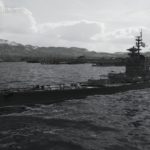
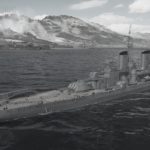
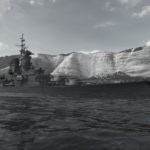
 Latest Facebook Entry -
Latest Facebook Entry -  X(Tweeter) Naval Encyclopedia's deck archive
X(Tweeter) Naval Encyclopedia's deck archive Instagram (@navalencyc)
Instagram (@navalencyc)





 French Navy
French Navy Royal Navy
Royal Navy Russian Navy
Russian Navy Armada Espanola
Armada Espanola Austrian Navy
Austrian Navy K.u.K. Kriegsmarine
K.u.K. Kriegsmarine Dansk Marine
Dansk Marine Nautiko Hellenon
Nautiko Hellenon Koninklije Marine 1870
Koninklije Marine 1870 Marinha do Brasil
Marinha do Brasil Osmanlı Donanması
Osmanlı Donanması Marina Do Peru
Marina Do Peru Marinha do Portugal
Marinha do Portugal Regia Marina 1870
Regia Marina 1870 Nihhon Kaigun 1870
Nihhon Kaigun 1870 Preußische Marine 1870
Preußische Marine 1870 Russkiy Flot 1870
Russkiy Flot 1870 Svenska marinen
Svenska marinen Søværnet
Søværnet Union Navy
Union Navy Confederate Navy
Confederate Navy Armada de Argentina
Armada de Argentina Imperial Chinese Navy
Imperial Chinese Navy Marinha do Portugal
Marinha do Portugal Mexico
Mexico Kaiserliche Marine
Kaiserliche Marine 1898 US Navy
1898 US Navy Sovietskiy Flot
Sovietskiy Flot Royal Canadian Navy
Royal Canadian Navy Royal Australian Navy
Royal Australian Navy RNZN Fleet
RNZN Fleet Chinese Navy 1937
Chinese Navy 1937 Kriegsmarine
Kriegsmarine Chilean Navy
Chilean Navy Danish Navy
Danish Navy Finnish Navy
Finnish Navy Hellenic Navy
Hellenic Navy Polish Navy
Polish Navy Romanian Navy
Romanian Navy Turkish Navy
Turkish Navy Royal Yugoslav Navy
Royal Yugoslav Navy Royal Thai Navy
Royal Thai Navy Minor Navies
Minor Navies Albania
Albania Austria
Austria Belgium
Belgium Columbia
Columbia Costa Rica
Costa Rica Cuba
Cuba Czechoslovakia
Czechoslovakia Dominican Republic
Dominican Republic Haiti
Haiti Hungary
Hungary Honduras
Honduras Estonia
Estonia Iceland
Iceland Eire
Eire Equador
Equador Iran
Iran Iraq
Iraq Latvia
Latvia Liberia
Liberia Lithuania
Lithuania Mandchukuo
Mandchukuo Morocco
Morocco Nicaragua
Nicaragua Persia
Persia San Salvador
San Salvador Sarawak
Sarawak Uruguay
Uruguay Venezuela
Venezuela Zanzibar
Zanzibar Warsaw Pact Navies
Warsaw Pact Navies Bulgaria
Bulgaria Hungary
Hungary

 Bundesmarine
Bundesmarine Dutch Navy
Dutch Navy Hellenic Navy
Hellenic Navy Marina Militare
Marina Militare Yugoslav Navy
Yugoslav Navy Chinese Navy
Chinese Navy Indian Navy
Indian Navy Indonesian Navy
Indonesian Navy JMSDF
JMSDF North Korean Navy
North Korean Navy Pakistani Navy
Pakistani Navy Philippines Navy
Philippines Navy ROKN
ROKN Rep. of Singapore Navy
Rep. of Singapore Navy Taiwanese Navy
Taiwanese Navy IDF Navy
IDF Navy Saudi Navy
Saudi Navy Royal New Zealand Navy
Royal New Zealand Navy Egyptian Navy
Egyptian Navy South African Navy
South African Navy






























 Ukrainian Navy
Ukrainian Navy dbodesign
dbodesign